#madame la dauphine
Text

Infanta María Teresa Rafaela de España, Delfina de Francia. By Jacopo Amigoni.
#jacopo amigoni#monarquía española#infantes de españa#casa de borbón#maria teresa rafaela de borbón#infanta de españa#delfina de francia#royaume de france#maison de bourbon#dauphine de france#madame la dauphine
4 notes
·
View notes
Text
renée de noailles from vying from versailles is the cuntiest woman to ever exist. she removed louise de la valliere from court and became the maîtresse-en-titre in her debut season at the ripe age of twenty.
then she proceeded to single handedly save the dauphin of france, frame and execute françois-athénaïs, madame de montespan and chevalier lou de rohan at the ripe age of twenty one.
now at twenty three, she's a duchess with her own retinue, with a new found relationship with hunger for power and corruption, a pro supporter of war.
truly serving cunt.
#romance club#vying for versailles#rc vying for versailles#renée de noailles#rc renée#rc VFV#Louis xiv#rc king louis#alexandre bontemps#rc alexandre#madame de montespan#Louise de la valliere#madame de maintenon watch out#mother of cunts#cunty behaviour#best mc
195 notes
·
View notes
Text


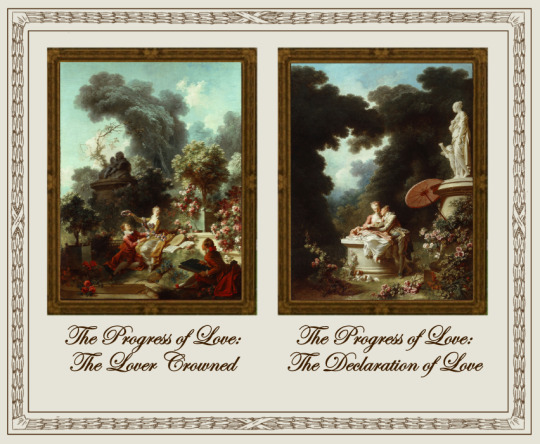
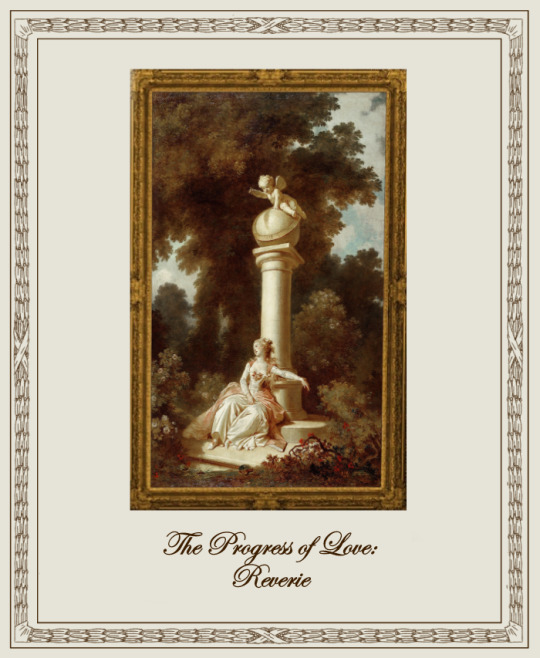
The Progress of Love Set
A retexture by La Comtesse Zouboff — Original Mesh by @thejim07
First of all, I'm terribly sorry for the lack of content lately, I've had some major issues and now my computer is not available to me, since it's being repaired, but in the meantime, enjoy this little rococo set!
The history of these paintings-one of the most powerful evocations of love in the history of art-is linked with the career of Jeanne Bécu, Countess du Barry the last mistress of Louis XV. For a pleasure pavilion in Louveciennes she commissioned from the architect Claude-Nicolas Ledoux in 1771, the countess ordered from Fragonard four canvases depicting "the four ages of love." The series advances in the following order: from a flirtatious proposal (the pursuit), to a furtive meeting (the lover scales the wall of a garden), to consummation or marriage (the girl crowns her lover with roses), to the calm enjoyment of a happy union (the reading of love letters). Yet, for all their beauty and passion, Madame du Barry soon returned the canvases to the artist and ordered replacements from another. Were the resemblances between the red-coated lover and Louis XV potentially embarrassing? Did the exuberant canvases seem a little old-fashioned amid the cool neoclassicism of Ledoux's avant- garde pavilion? For whatever reason, Fragonard was left holding on to his creations for another twenty years. Then, adding seven more canvases, (although the original series contains five canvases) he installed the series in a cousin's villa in southern France. They passed through the collection of J. P. Morgan, where they were displayed in his London house. They were acquired by Frick in 1915 and installed in a room specially designed for them where they remain to this day.
-------------------------------------------------------
This set contains 5 paintings with the original frame swatches, fully recolourable. They are:
The Progress of Love: The Pursuit.
The Progress of Love: The Meeting.
The Progress of Love: The Lover Crowned.
The Progress of Love: The Declaration of Love.
The Progress of Love: Reverie.
Found under decor > paintings for: 3.900§ (1-4) and 3.560§ (5)
Retextured from:
"Portrait of Maria Theresa of Austria and her Son, le Grand Dauphin" (1-4) found here
"Length Portrait of Mrs.D" (5) found here

Drive
(Sims3pack | Package)
(Useful tags below)
@joojconverts @ts3history @ts3historicalccfinds @deniisu-sims @katsujiiccfinds @gifappels-stuff
-------------------------------------------------------
#the sims 3#ts3#s3cc#sims 3#sims 3 cc#sims 3 download#sims 3 decor#portrait#wall decor#fragonard#rococo
79 notes
·
View notes
Text
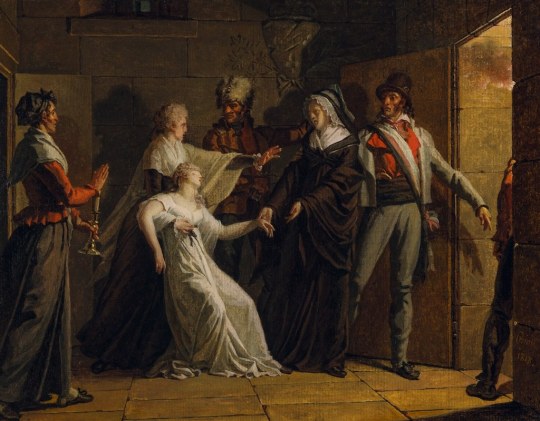
Jacques Augustin Pajou - Marie Antoinette séparée de sa famille au temple - 1818
Marie Antoinette (Marie Antoinette Josèphe Jeanne; 2 November 1755 – 16 October 1793) was the last queen of France prior to the French Revolution. She was born an archduchess of Austria, and was the penultimate child and youngest daughter of Empress Maria Theresa and Emperor Francis I. She became dauphine of France in May 1770 at age 14 upon her marriage to Louis-Auguste, heir apparent to the French throne. On 10 May 1774, her husband ascended the throne as Louis XVI and she became queen.
As queen, Marie Antoinette became increasingly unpopular among the people; the French libelles accused her of being profligate, promiscuous, having illegitimate children, and harboring sympathies for France's perceived enemies, including her native Austria. She was falsely accused in the Affair of the Diamond Necklace, but the accusations damaged her reputation further. During the French Revolution, she became known as Madame Déficit because the country's financial crisis was blamed on her lavish spending and her opposition to social and financial reforms proposed by Anne Robert Jacques Turgot and Jacques Necker.
Several events were linked to Marie Antoinette during the Revolution after the government placed the royal family under house arrest in the Tuileries Palace in October 1789. The June 1791 attempted flight to Varennes and her role in the War of the First Coalition were immensely damaging to her image among French citizens. On 10 August 1792, the attack on the Tuileries forced the royal family to take refuge at the Assembly, and they were imprisoned in the Temple Prison on 13 August. On 21 September 1792, the monarchy was abolished. Louis XVI was executed by guillotine on 21 January 1793. Marie Antoinette's trial began on 14 October 1793; she was convicted two days later by the Revolutionary Tribunal of high treason and executed, also by guillotine, at the Place de la Révolution.
Jacques-Augustin-Catherine Pajou (27 August 1766, Paris - 28 November 1828, Paris) was a French painter in the Classical style.
10 notes
·
View notes
Note
Do you have any recommendations for perfumes that have a kind of "Marie Antoinette at the Trianon" feel?
do i ever!
versailles by poesie: actually a marie antoinette-inspired gourmand. orange blossoms, citrusy cake. ideal for a garden tea party.
juliet by bpal is a rounded pear and white floral. very juicy, with that naïve feeling that would not be out of place for madame la dauphine.
echoed ecstasy by alkemia: a tumble on a grassy slope, strawberry-stained mouths, fresh ginger and lemon. there's a bubbly fizz to it, almost like champagne.
delina la rosée by parfums de marly: the chemise à la reine to the original delina's silk gown: fresher, tinged by a bit of green, younger.
insolence EDT by guerlain: i just think marie antoinette would like insolence. bright, clean violets, a glimpse of orange blossom, red berries, and the classic guerlain heart accord.
and how could i forget historiae's bouquet du trianon! inspired by her actual perfume and the trianon's gardens.
13 notes
·
View notes
Text
marie antoinette hit with chamber pot waste? rabbit hole help.
I'm going down a source rabbit hole and trying to trace the source of a claim that Marie Antoinette and the comtesse de Provence were once hit with the contents of a chamber pot dumped from the windows of Madame du Barry's apartment (or any apartment).
So far, the only concrete sources I've found are:
Tony Spawforth's 'Versailles: A Biography.'
The citations lead to: two pages in a book which aren't discussing Marie Antoinette, one page which has a bit of text written by someone who was writing about other people's servants throwing waste out the window (but not hitting anyone) and a book from 1950 which I have to get from the library hold, which could take a few weeks.
Will Bashor's "Marie Antoinette's World'
(A book with many many issues that I need to get around reviewing) which includes the "Du Barry" window anecdote with no citation, and claims Marie Antoinette was hit with a chamber pot on another occasion and includes a quote about "Madame la dauphine" being hit with a chamber pot... but the quote written in 1764 and was not, contrary to Bashor's claim, written about Marie Antoinette.
And that's it as far as actual sources go.
I could have sworn there was something about this in the Mercy/Maria Theresa correspondence, but now I can't find it. I'm wondering if it wasn't included in a first person novel that I read years ago and my brain has confused the two.
Does anyone have any leads?
15 notes
·
View notes
Photo

“Reminiscences.”
A portrait in the style of the 18th Century depicting Queen Marie-Antoinette of France with two of her four children (only two survived the beginning of the Revolution); Marie-Thérèse Charlotte, or Madame Royale was the only one of the four who survived into adulthood, her youngest brother, Louis-Charles, the Dauphin (after his elder brother died in 1789) having died in the Temple Prison from neglect and abuse.
Surrounding mother and children are mementos of Marie-Antoinette's life at Versailles. Along the left are hangings from the Cabinet de la Méridienne, which is currently being restored to how it looked in 1789. Along the right, filling the back-ground is the Petit Trianon which was her escape from the rigid protocol of the Court of Versailles. At the bottom right-hand corner, a table with a basket of oranges scattered with orange blossoms which was one of the fruits that the Queen had planted in the grounds of Versailles. Lastly, at the top right-hand corner is the Queen's cypher bordered with flowers.
I had a lot of fun with this one. ^_^
#18thcentury#18thcenturyfrance#marieantoinette#queenoffrance#reminiscences#marietheresecharlotte#madameroyale#louischarles#dauphin#louisxvii#chateaudeversailles#petittrianon#oranges#flowers#portraiture#illustration#pencildrawing#traditionalart
14 notes
·
View notes
Text
“Vive La Reine!”

“I know the fate awaiting me”, the Queen replies, with magnanimity, “but my duty is to die at the feet of the king and in the arms of my children.” It is clear by her tone of voice, that she is frightened, but by God, she nonetheless behaves like every inch the Queen of old and noble France. You allow yourself a small smile, this might just work.
“Well then, madam, come with me”, you invite her and offer her your arm.
“What! alone on the balcony? Did you not see the signs they made me?”, she retorts, her eyes wide open and her face flushed with fear.
Of course have you seen the signs made, and they were horrible indeed. Nobody is deserving of such treatment, but this is exactly why you must act now. “Yes, madam, but let us go”, you tell the Queen and turn to look at the King. He simply nods.
You step out on the balcony with the Queen beside you and her small children, the Dauphin and the Princess Royal. But as soon as you step outside, there is an outcry from the people below the balcony to send the children back inside. Good, you think. At least then they are safe, at least they do not have to see their mother murdered should the events take a turn for the worse.
You try to address the people, but you can not make yourself heard, regardless of how much you strain your voice. Pity, you had, in the heat of the moment, come up with a few pretty things to say. But since speaking seems no longer to be an option, you decide to let actions speak for you. You bow down as low as you can in front of your Queen and give her hand a gallant kiss. Let the crowd see that you are still loyal to the Royal Family and the people will hopefully follow your lead.
It works. You hear the crowd below cry out: “Long live the General!” and “Long live the Queen!” You allow yourself the second little smile this morning as you lead the Queen back inside. That went down rather well. But there is still no ends to your troubles as the King approaches you. “What are you now able to do for my guards?”
His guards? Really now? You are a soldier, not a savior! What does he think you can do? There is nothing you can do for the King’s guards.
Well, appearing in front of the people on the balcony has worked twice so far and if the King asks you, you are willing to try it a third time. Surely you will be able to coax the National Guard into a display of camaraderie.
Historical Context:
Again, this scene happened almost exactly as described here. La Fayette later noted in his Memoirs:
(…) and when the king and his family; after having promised to go to Paris, had retired from that balcony, “Madame,” said he to the queen, “what are your intentions as respects yourself?” “I know the fate awaiting me,” she replied, with magnanimity, “but my duty is to die at the feet of the king and in the arms of my children.” “Well then, madam, come with me.” “What! alone on the balcony? Did you not see the signs they made me?” And those signs had been horrible, in truth. “Yes, madam, but let us go.” And when, appearing with her before that tumultuous populace, still raging, like the waves of a stormy ocean between a hedge of national guards, who lined three sides of the court but could not control the centre, Lafayette, unable to make himself heard, had recourse to a decisive but hazardous sign; he kissed the hand of the Queen. The multitude, struck by that action, exclaimed, “Long live the general!” “Long live the queen!”
Marquis de La Fayette, Memoirs, Correspondences and Manuscripts of General Lafayette, Vol. 2, Craighead and Allen, New York, 1837, p. 327.
#there is cromwell#choose your own adventure#alternate history#history#french history#french revolution#1789#marie antoinette#louis xvi#macrh of the women on versailles#marquis de lafayette
6 notes
·
View notes
Photo

Simone Simon and Daniel Gélin in Le Plaisir (Max Ophüls, 1952)
Cast: Claude Dauphin, Gaby Morlay, Madeleine Renaud, Ginette Leclerc, Mila Parély, Danielle Darrieux, Pierre Brasseur, Jean Gabin, Jean Servais, Daniel Gélin, Simone Simon, Paul Azaïs. Screenplay: Jacques Natanson, Max Ophüls, based on stories by Guy de Maupassant. Cinematography: Philippe Agostini, Christian Matras. Production design: Jean d’Aubonne. Film editing: Léonide Azar. Music: Joe Hajos.
Pleasure, as the poets never tire of telling us, is inextricable from pain. Le Plaisir is an anthology film dramatizing three stories by Guy de Maupassant that center on what has been called the pleasure-pain perplex. An elderly man nearly dances himself to death in an attempt to recapture his youth. The patrons of a brothel quarrel and even come to blows when they discover that it is closed. An artist marries his mistress to atone for his cruelty to her. Max Ophüls brings all of his elegant technique to the stories, including his characteristic restless camera, which prowls around the wonderful sets by Jean d'Eaubonne, who received a well-deserved Oscar nomination for art direction. It's also, like Ophuls's La Ronde (1950), an all-star production -- if your stars are French. Claude Dauphin plays the doctor who treats the youth-seeking dancer; Madeleine Renaud is the madame of the brothel, Danielle Darrieux is one of her "girls," and Jean Gabin plays the madame's brother, who invites her to bring the girls to the country for his daughter's first communion, hence the temporary closure of the brothel; Daniel Gélin is the artist, Simone Simon his model/mistress, and Jean Servais his friend who also narrates the final section. Of the three segments of the film, the middle one is the longest and I think the most successful, moving from the raucous opening scene in which the men of the small Normandy town discover the brothel closed into a comic train ride to the country, which is as fetchingly pastoral a setting as you could wish. The sequence climaxes with the filles de joie dissolving in tears at the first communion -- the little church in which it takes place is one of d'Eaubonne's most inspired sets -- then returning to town and a joyous welcome. Ophuls never lets us inside the brothel: We see it only as voyeurs, through the windows. Nothing of this segment is "realistic" in the least, making the melancholy first and last segments more important in establishing the film's theme and tone. The first segment does its part to set up the course of the film as a whole, beginning with a riotous opening as tout Paris flocks to the opening of a dance hall, a pleasure palace, followed by scenes of lively dancing, then the collapse of the elderly patron, who is wearing a frozen and rather creepy mask of youth, and concluding with the bleakness of his normal existence, tended by his aging wife, who is fittingly played by Gaby Morlay, once a silent film gamine. The final segment is the bleakest of all, as the film concludes with the artist pushing his wheelchair-bound wife along the seashore, penance for having provoked her suicide attempt.
12 notes
·
View notes
Text
The Year 1817
Volume 1: Fantine; Book 3: In The Year 1817; Chapter 1: The Year 1817
1817 is the year which Louis XVIII., with a certain royal assurance which was not wanting in pride, entitled the twenty-second of his reign. It is the year in which M. Bruguière de Sorsum was celebrated. All the hairdressers’ shops, hoping for powder and the return of the royal bird, were besmeared with azure and decked with fleurs-de-lys. It was the candid time at which Count Lynch sat every Sunday as church-warden in the church-warden’s pew of Saint-Germain-des-Prés, in his costume of a peer of France, with his red ribbon and his long nose and the majesty of profile peculiar to a man who has performed a brilliant action. The brilliant action performed by M. Lynch was this: being mayor of Bordeaux, on the 12th of March, 1814, he had surrendered the city a little too promptly to M. the Duke d’Angoulême. Hence his peerage. In 1817 fashion swallowed up little boys of from four to six years of age in vast caps of morocco leather with ear-tabs resembling Esquimaux mitres. The French army was dressed in white, after the mode of the Austrian; the regiments were called legions; instead of numbers they bore the names of departments; Napoleon was at St. Helena; and since England refused him green cloth, he was having his old coats turned. In 1817 Pelligrini sang; Mademoiselle Bigottini danced; Potier reigned; Odry did not yet exist. Madame Saqui had succeeded to Forioso. There were still Prussians in France. M. Delalot was a personage. Legitimacy had just asserted itself by cutting off the hand, then the head, of Pleignier, of Carbonneau, and of Tolleron. The Prince de Talleyrand, grand chamberlain, and the Abbé Louis, appointed minister of finance, laughed as they looked at each other, with the laugh of the two augurs; both of them had celebrated, on the 14th of July, 1790, the mass of federation in the Champ de Mars; Talleyrand had said it as bishop, Louis had served it in the capacity of deacon. In 1817, in the side-alleys of this same Champ de Mars, two great cylinders of wood might have been seen lying in the rain, rotting amid the grass, painted blue, with traces of eagles and bees, from which the gilding was falling. These were the columns which two years before had upheld the Emperor’s platform in the Champ de Mai. They were blackened here and there with the scorches of the bivouac of Austrians encamped near Gros-Caillou. Two or three of these columns had disappeared in these bivouac fires, and had warmed the large hands of the Imperial troops. The Field of May had this remarkable point: that it had been held in the month of June and in the Field of March (Mars). In this year, 1817, two things were popular: the Voltaire-Touquet and the snuff-box à la Charter. The most recent Parisian sensation was the crime of Dautun, who had thrown his brother’s head into the fountain of the Flower-Market.
They had begun to feel anxious at the Naval Department, on account of the lack of news from that fatal frigate, The Medusa, which was destined to cover Chaumareix with infamy and Géricault with glory. Colonel Selves was going to Egypt to become Soliman-Pasha. The palace of Thermes, in the Rue de La Harpe, served as a shop for a cooper. On the platform of the octagonal tower of the Hotel de Cluny, the little shed of boards, which had served as an observatory to Messier, the naval astronomer under Louis XVI., was still to be seen. The Duchesse de Duras read to three or four friends her unpublished Ourika, in her boudoir furnished by X. in sky-blue satin. The N’s were scratched off the Louvre. The bridge of Austerlitz had abdicated, and was entitled the bridge of the King’s Garden [du Jardin du Roi], a double enigma, which disguised the bridge of Austerlitz and the Jardin des Plantes at one stroke. Louis XVIII., much preoccupied while annotating Horace with the corner of his finger-nail, heroes who have become emperors, and makers of wooden shoes who have become dauphins, had two anxieties,—Napoleon and Mathurin Bruneau. The French Academy had given for its prize subject, The Happiness procured through Study. M. Bellart was officially eloquent. In his shadow could be seen germinating that future advocate-general of Broë, dedicated to the sarcasms of Paul-Louis Courier. There was a false Chateaubriand, named Marchangy, in the interim, until there should be a false Marchangy, named d’Arlincourt. Claire d’Albe and Malek-Adel were masterpieces; Madame Cottin was proclaimed the chief writer of the epoch. The Institute had the academician, Napoleon Bonaparte, stricken from its list of members. A royal ordinance erected Angoulême into a naval school; for the Duc d’Angoulême, being lord high admiral, it was evident that the city of Angoulême had all the qualities of a seaport; otherwise the monarchical principle would have received a wound. In the Council of Ministers the question was agitated whether vignettes representing slack-rope performances, which adorned Franconi’s advertising posters, and which attracted throngs of street urchins, should be tolerated. M. Paër, the author of Agnese, a good sort of fellow, with a square face and a wart on his cheek, directed the little private concerts of the Marquise de Sasenaye in the Rue Ville l’Évêque. All the young girls were singing the Hermit of Saint-Avelle, with words by Edmond Géraud. The Yellow Dwarf was transferred into Mirror. The Café Lemblin stood up for the Emperor, against the Café Valois, which upheld the Bourbons. The Duc de Berri, already surveyed from the shadow by Louvel, had just been married to a princess of Sicily. Madame de Staël had died a year previously. The body-guard hissed Mademoiselle Mars. The grand newspapers were all very small. Their form was restricted, but their liberty was great. The Constitutionnel was constitutional. La Minerve called Chateaubriand Chateaubriant. That t made the good middle-class people laugh heartily at the expense of the great writer. In journals which sold themselves, prostituted journalists, insulted the exiles of 1815.
David had no longer any talent, Arnault had no longer any wit, Carnot was no longer honest, Soult had won no battles; it is true that Napoleon had no longer any genius. No one is ignorant of the fact that letters sent to an exile by post very rarely reached him, as the police made it their religious duty to intercept them. This is no new fact; Descartes complained of it in his exile. Now David, having, in a Belgian publication, shown some displeasure at not receiving letters which had been written to him, it struck the royalist journals as amusing; and they derided the prescribed man well on this occasion. What separated two men more than an abyss was to say, the regicides, or to say the voters; to say the enemies, or to say the allies; to say Napoleon, or to say Buonaparte. All sensible people were agreed that the era of revolution had been closed forever by King Louis XVIII., surnamed “The Immortal Author of the Charter.” On the platform of the Pont-Neuf, the word Redivivus was carved on the pedestal that awaited the statue of Henry IV. M. Piet, in the Rue Thérèse, No. 4, was making the rough draft of his privy assembly to consolidate the monarchy. The leaders of the Right said at grave conjunctures, “We must write to Bacot.” MM. Canuel, O’Mahoney, and De Chappedelaine were preparing the sketch, to some extent with Monsieur’s approval, of what was to become later on “The Conspiracy of the Bord de l’Eau”—of the waterside. L’Épingle Noire was already plotting in his own quarter. Delaverderie was conferring with Trogoff. M. Decazes, who was liberal to a degree, reigned. Chateaubriand stood every morning at his window at No. 27 Rue Saint-Dominique, clad in footed trousers, and slippers, with a madras kerchief knotted over his gray hair, with his eyes fixed on a mirror, a complete set of dentist’s instruments spread out before him, cleaning his teeth, which were charming, while he dictated The Monarchy according to the Charter to M. Pilorge, his secretary. Criticism, assuming an authoritative tone, preferred Lafon to Talma. M. de Féletez signed himself A.; M. Hoffmann signed himself Z. Charles Nodier wrote Thérèse Aubert. Divorce was abolished. Lyceums called themselves colleges. The collegians, decorated on the collar with a golden fleur-de-lys, fought each other apropos of the King of Rome. The counter-police of the château had denounced to her Royal Highness Madame, the portrait, everywhere exhibited, of M. the Duc d’Orléans, who made a better appearance in his uniform of a colonel-general of hussars than M. the Duc de Berri, in his uniform of colonel-general of dragoons—a serious inconvenience. The city of Paris was having the dome of the Invalides regilded at its own expense. Serious men asked themselves what M. de Trinquelague would do on such or such an occasion; M. Clausel de Montals differed on divers points from M. Clausel de Coussergues; M. de Salaberry was not satisfied. The comedian Picard, who belonged to the Academy, which the comedian Molière had not been able to do, had The Two Philiberts played at the Odéon, upon whose pediment the removal of the letters still allowed THEATRE OF THE EMPRESS to be plainly read. People took part for or against Cugnet de Montarlot. Fabvier was factious; Bavoux was revolutionary. The Liberal, Pélicier, published an edition of Voltaire, with the following title: Works of Voltaire, of the French Academy. “That will attract purchasers,” said the ingenious editor. The general opinion was that M. Charles Loyson would be the genius of the century; envy was beginning to gnaw at him—a sign of glory; and this verse was composed on him:—
“Even when Loyson steals, one feels that he has paws.”
As Cardinal Fesch refused to resign, M. de Pins, Archbishop of Amasie, administered the diocese of Lyons. The quarrel over the valley of Dappes was begun between Switzerland and France by a memoir from Captain, afterwards General Dufour. Saint-Simon, ignored, was erecting his sublime dream. There was a celebrated Fourier at the Academy of Science, whom posterity has forgotten; and in some garret an obscure Fourier, whom the future will recall. Lord Byron was beginning to make his mark; a note to a poem by Millevoye introduced him to France in these terms: a certain Lord Baron. David d’Angers was trying to work in marble. The Abbé Caron was speaking, in terms of praise, to a private gathering of seminarists in the blind alley of Feuillantines, of an unknown priest, named Félicité-Robert, who, at a latter date, became Lamennais. A thing which smoked and clattered on the Seine with the noise of a swimming dog went and came beneath the windows of the Tuileries, from the Pont Royal to the Pont Louis XV.; it was a piece of mechanism which was not good for much; a sort of plaything, the idle dream of a dream-ridden inventor; an utopia—a steamboat. The Parisians stared indifferently at this useless thing. M. de Vaublanc, the reformer of the Institute by a coup d’état, the distinguished author of numerous academicians, ordinances, and batches of members, after having created them, could not succeed in becoming one himself. The Faubourg Saint-Germain and the pavilion de Marsan wished to have M. Delaveau for prefect of police, on account of his piety. Dupuytren and Récamier entered into a quarrel in the amphitheatre of the School of Medicine, and threatened each other with their fists on the subject of the divinity of Jesus Christ. Cuvier, with one eye on Genesis and the other on nature, tried to please bigoted reaction by reconciling fossils with texts and by making mastodons flatter Moses.
M. François de Neufchâteau, the praiseworthy cultivator of the memory of Parmentier, made a thousand efforts to have pomme de terre [potato] pronounced parmentière, and succeeded therein not at all. The Abbé Grégoire, ex-bishop, ex-conventionary, ex-senator, had passed, in the royalist polemics, to the state of “Infamous Grégoire.” The locution of which we have made use—passed to the state of—has been condemned as a neologism by M. Royer Collard. Under the third arch of the Pont de Jéna, the new stone with which, the two years previously, the mining aperture made by Blücher to blow up the bridge had been stopped up, was still recognizable on account of its whiteness. Justice summoned to its bar a man who, on seeing the Comte d’Artois enter Notre Dame, had said aloud: “Sapristi! I regret the time when I saw Bonaparte and Talma enter the Bel Sauvage, arm in arm.” A seditious utterance. Six months in prison. Traitors showed themselves unbuttoned; men who had gone over to the enemy on the eve of battle made no secret of their recompense, and strutted immodestly in the light of day, in the cynicism of riches and dignities; deserters from Ligny and Quatre-Bras, in the brazenness of their well-paid turpitude, exhibited their devotion to the monarchy in the most barefaced manner.
This is what floats up confusedly, pell-mell, for the year 1817, and is now forgotten. History neglects nearly all these particulars, and cannot do otherwise; the infinity would overwhelm it. Nevertheless, these details, which are wrongly called trivial,—there are no trivial facts in humanity, nor little leaves in vegetation,—are useful. It is of the physiognomy of the years that the physiognomy of the centuries is composed. In this year of 1817 four young Parisians arranged “a fine farce.”
13 notes
·
View notes
Note
This is a little scattered, I'm sorry..
With regards to Margaret of York: while Margaret working to restore (supposed) "Yorkist" rule would obviously mean that Elizabeth of York's husband would be overthrown (and probably executed) and Elizabeth herself would no longer be queen ... I think it's important to remember that Elizabeth of York was a Yorkist herself. Margaret's actions would literally be placing Elizabeth's (alleged) cousin and, more importantly, Elizabeth's (alleged) brother on the throne. They were very clearly Pretenders, but that doesn't change the fact that if they got the throne, they would be required to treat Elizabeth (as their apparent sister and eldest daughter of the Yorkist king) with honour and respect.
And imo, it's entirely possible that Margaret thought she was doing Elizabeth a favour: it's clear that Henry VII and Elizabeth had a loving and supportive marriage, and the aftermath of Edward Iv's death resulted in a Yorkist division with Henry VII supported by Edwardian Yorkists, that doesn't change the fact that Henry had very evidently married Elizabeth for her claim and to secure support for his reign, and there is no shortage of women in history who were forced into marriages like that. While Elizabeth certainly wasn't, we don't know what Margaret thought about it (she might have believed that with Henry out of the way, Elizabeth would be happy with a resumed Yorkist rule) so it's impossible to say.
I'm not trying to miminise the personal trauma EoY would undoubtedly go through, but I feel like lots of people's assumptions on EoY's potential fate are similar to the (genuinely horrifying) fate actually endured by her mother, Elizabeth Woodville, due to R3's usurption. Which EoY almost certainly would not have had to undergo, as she (and Margaret of Anjou during her time) had powerful heritages and powerful backing due to those heritages that would have aided them (and definitely did, in Margaret's case) in their goals and the dignity afforded to them. In EoY's case, from what I understand, the worst case scenario she would have to endure (politically speaking) is her title reverting back to a royal princess rather than a queen.
Idk, just my thoughts.
Hi! It's impossible for us to know how Margaret of York felt or thought about Elizabeth of York. When she left England Elizabeth was just two years old, then, when Margaret visited England again in 1480, Elizabeth was the 'Madame la Dauphine' whose betrothal to the future Charles VIII clashed with Margaret's interests in pulling England into a war against France, and Edward IV explicitly told his sister so — that is, Elizabeth seems to have always been in a 'relationship' with someone who was bad for Margaret's interests lol. Undoubtedly, no one was expecting Elizabeth to be executed if Henry VII was deposed. I think it's quite possible she would be used to make marriage alliances if she had indeed been widowed the way that they wanted: we know Maximilian, Margaret's ally and the regent of her duchy, for example, had been interested in marrying Elizabeth of York even after Henry's victory at Bosworth. Given her age, I really don't think they would allow Elizabeth to 'retire' to a convent and live out her days as a royal widow.
Now, as to the possibility that Margaret thought she was doing Elizabeth a favour in getting rid of her husband, one very important question, of course, remains in that scenario: what would happen to Elizabeth's children with Henry? When Margaret backed the Lambert Simnel rebellion, Elizabeth had a son who was less than a year old. When Margaret declared her support for Perkin Warbeck, Elizabeth had already four children with Henry, including a seven-year-old and a two-year-old son. I doubt it wouldn't have been very painful for Elizabeth if they managed to depose her husband, given what would happen to her sons (imprisonment or death), regardless if she had been forced into that marriage or not. I really don't think Margaret had Elizabeth's personal interests in mind, but that was just the normal politics of the age.
9 notes
·
View notes
Text
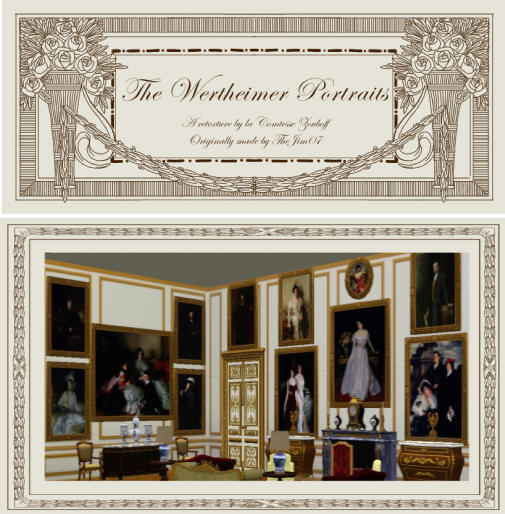
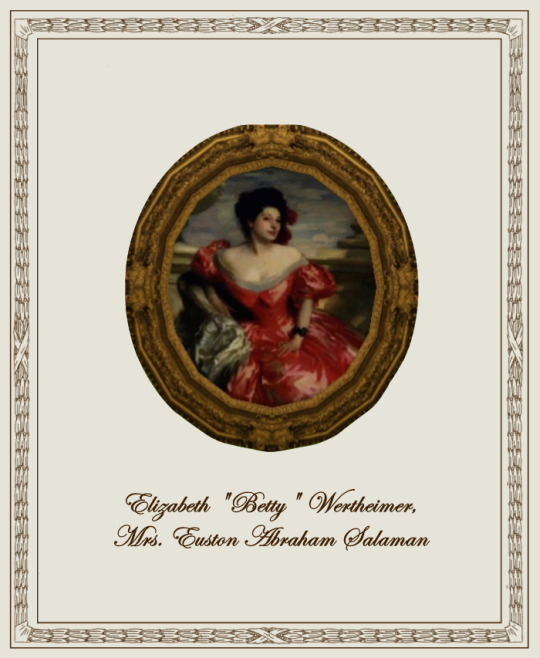
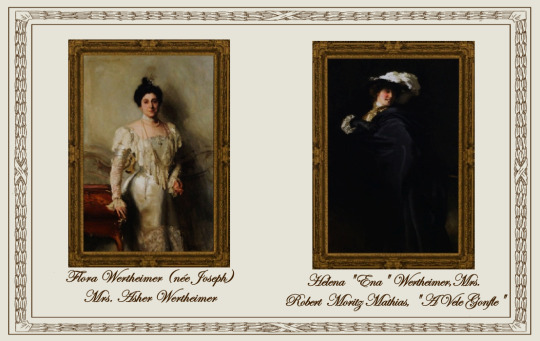



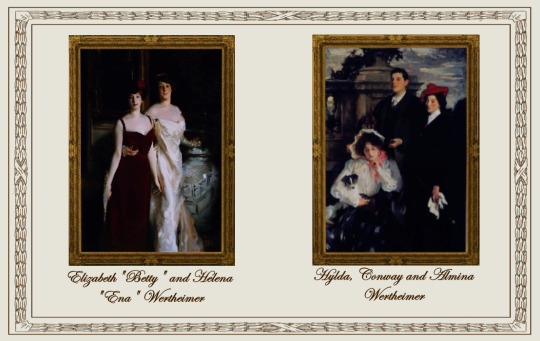
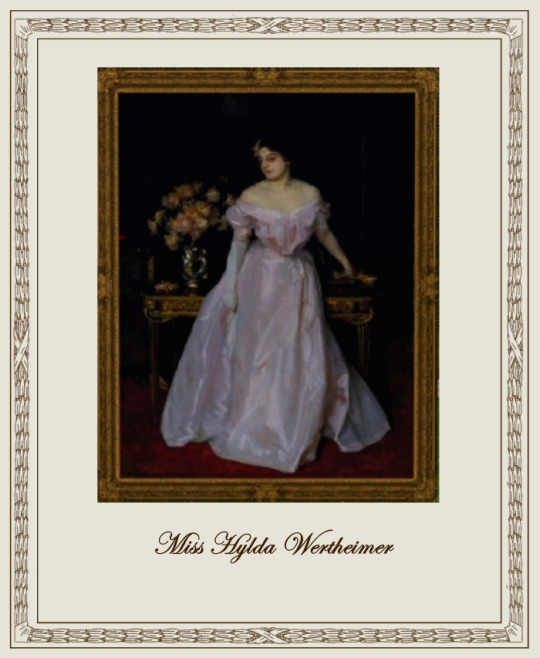

The Wertheimer Portraits
A retexture by La Comtesse Zouboff — Original Mesh by @thejim07
The Wertheimer portraits are a series of twelve portrait paintings made by John Singer Sargent of and for the British art dealer Asher Wertheimer and his family. The series amounts to Sargent's largest private commission.
The family became close friends of the artist John Singer Sargent. He often dined at their home at 8 Connaught Place, where the dining room (sometimes described as "Sargent's mess" ) was decorated with eight of the family portraits. Mr and Mrs Wertheimer commissioned Singer Sargent to paint two portraits to celebrate their 25th wedding anniversary in 1898, and ten more commissions followed in the next decade. Most of the portraits hang in the Tate Museum in London, after Wertheimer's death in 1918. The donation was an scandal, as some antisemitic comments emerged, such as that of the historian Sir Charles Oman: "these clever, but extremely repulsive, pictures should be placed in a special chamber of horrors".
The bequest and wish for the portraits to be displayed together was seen as a distasteful display of wealth with opponents claiming it was Jewish excess and asking “Is there any other gallery that has been given so many paintings?
Since the paintings would hang among royalty, clergy and historical figures, to have a room dedicated to one family deemed outside the British establishment was so controversial that it was debated in Parliament.
Nowadays, the portraits are regarded as masterpieces, and most of the antisemitic comments remained in the past, but some critics have thought that the paintings "exudes caricature-like features and projected racial stereotypes onto the sitters" although the family was perfectly happy with them (of course this wouldn't have been issue if the family belonged to catholicism or other western-predominant religion)
This set contains 12 portraits, with the original frame swatches, fully recolourable. They are of:
Elizabeth "Betty" Wertheimer, Mrs. Euston Abraham Salaman (oval shape)
Flora Wertheimer (née Joseph) Mrs. Asher Wertheimer
Helena "Ena" Wertheimer, Mrs. Robert Moritz Mathias, "A Vele Gonfle"
Madame Asher Wertheimer (née Flora Joseph) (another portrait of Flora)
Miss Almina Wertheimer in Turquerie Costume.
Mr. Alfred Wertheimer
Edward Wertheimer (unfinished)
Asher Wertheimer with his Poodle, Noble.
Elizabeth "Betty" and Helena "Ena" Wertheimer.
Hylda, Conway and Almina Wertheimer.
Miss Hylda Wertheimer.
Ruby, Ferdinand and Essie Wertheimer.
Found under decor > paintings for:
500§ (1)
1.850§ (2-3-4-5-6-7-8)
3.040§ (9-10)
3.900§ (11)
6520§ (12)
Retextured from:
"Saint Mary Magdalene" (1) found here
"The virgin of the Rosary" (2-3-4-5-6-7-8) found here
"Portrait of Mariana of Austria in Prayer" (9-10) found here
"Portrait of Maria Theresa of Austria and her Son, le Grand Dauphin" (11) found here
"Vulcan's Forge" (12) found here
Thing to know before download: The pictures are not as dark as in this post, the lighting was awful in the screenshots.
-------------------------------------------------------
CC shown here:
Walls, floor and loveseat by @thejim07
Bust, urns, fireplace, clock, vases, candelabras, pendule à cercles tournants, door and screen by @joojconverts
Armchairs by ShinoKCR (tsr)
Rug by me, found here
Sideboard, chairs, sidetables and sofa by @martassimsbookcc
Commodes by Parsimonious Sims

Drive
(Sims3Pack | Package)
(Useful tags below)
@joojconverts @ts3history @ts3historicalccfinds @deniisu-sims @katsujiiccfinds @gifappels-stuff
-------------------------------------------------------
#the sims 3#ts3#s3cc#sims 3#sims 3 cc#sims 3 download#portrait#sims 3 decor#edwardian#edwardian art#john singer sargent#wertheimer#wall decor
113 notes
·
View notes
Photo
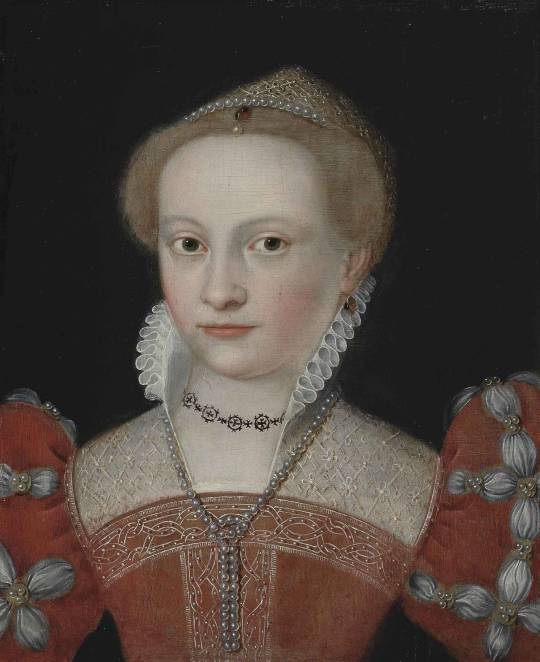
Portrait of a Lady in a red dress with a pearl headdress (Renée d'Anjou, Princess-Dauphine of Auvergne) by a follwer of François Clouet.
His father (Nicolas I of Anjou-Mézières) was the last descendant of the Dukes of Anjou, through the bastard son of Charles IV of Maine, Louis, Baron of Mézières.
Wife of François de Bourbon, Duke of Montpensier, mother of Henri de Bourbon, Duke of Montpensier, she inspired Madame de La Fayette for her Princesse de Montpensier.
#royaume de france#maison d'anjou#house of anjou#renée d'anjou#anjou#Anjou Mézières#french aristocracy
14 notes
·
View notes
Note
Favorite Danielle Darrieux films?
Favorite character names?
Thank you so much for asking!! ⭐️
Favorite Danielle Darrieux films:
There are so many!! my fave is Battement de coeur (1940) because she is so cute in it, love her chemistry with Claude Dauphin and the song is perfect. That’s what we call in depth film analysis!! I also would recommend Madame De, la vérité sur bébé donge, and obviously les demoiselles de Rochefort. But also the rage of Paris? Mayerling? Huit femmes? Arghhhhh
Favorite character names:
Hubert Bonisseur de la Batte, and Angélique de Ridoué de Sancé de Monteloup Comtesse de Peyrac. That’s 2 names that deserve the guillotine. Not great bob. Also, 우영우! 기러기 토마토 스위스 인도인 etc
3 notes
·
View notes
Text
Tuesday 29 July 1834
7
12 ¼
no kiss very fine morning F71° at 8 - breakfast at 8 ½ - off in caleche (taking both the servants) at 9 ¾ - fine drive – the valley of Chambery enclosed by fine Salèvelike but wooded mountains very fine – the Dent de Nivolet – a bare hoary limestone head a striking object on our right - Enter Aix at 11 10 – the road side near at Gressy [Gressy-sur-Aix] at 11 38 walked down a little way to the corn and rape oil mill in whose premises is the famous cascade – very little water – the limestone rock left bare so that we could well see the holes in which it is the water [worm] 10 June 1813 there - was merely a plank over the hole (14ft. deep) in which Madame la baronne de Broc was lost - now there is a good step-ladder over it with a rail on each side, and no danger at all - merely a cottage near the road side where we alighted and a swarm of children tormenting us with who should shew us to the cascade - the clefts down which the water falls into a sort of basin below the mill very pretty now - must be very much so, and fine when the water is abundant, foaming and gushing in on all sides - Off from Gressy [Gressy-sur-Aix] at 12 and at Port Puer on the lake de Bourget in 22 minutes – a boat just putting with a Lyons tradesman and his wife and child so that we were embarked and off at 12 25 – in 36 minutes ½ way and landed at 1 53 at Hautecombe - lake 4 lieues by 1 - 466ft. deep about the middle over against St. Innocent’s church belongs or did formerly to the marquis de St. Innocent - the fishermen of all the towns on the lake take it of government at 4500fr. a year paid 4terly - 2 trout caught the other day weighing 25lbs. each, worth 5fr. a lb.! the dead to be buried at Hautecombe are embarked at a village about St. Innocent at Brison [Brison-Saint-Innocent]a village of 26 houses - the lake shut in E. and W. by high, calcareous, hoary, wooded mountains in the style of Annecy, and North by the castle topped conical mountain of Châtillon, and South by the distant snow-striped mountains of Montmélian and Dauphine - Hautecombe about 2/3 up the lake on the west is a fine large building - on the same side seeming about midway between there and Aix is the vaunted dent du chat - the wind a little against in going but the water very smooth - A- rather frightened but behaved very well – the water was smooth as glass both ways particularly in returning - on landing, wanted to buy some fish from one of the boats – Lavarets (selmo Lavaretus Linnaeus) weighing 1lb. each, asked 4fr. a piece and would only come down to 3/75 so did not buy any - the boatmen said they would sell them at 3/. each at Aix - many strangers at the convent - 10 white monks of St. Bernard or Benoit - went immediately to the church – several people there – a monk explaining – found him very civil – the church will be done in November – all the sculpture done in Pierre de Seyssel (the quarry in France part of the territory in Savoy said the monk) which looked so exactly as if it has been white washed that we thought it was still convinced to the contrary - the fine fresco-paintings in the church and palace done by Vacca of Turin, the sculpture very good by [Caracciatori] of Carrara - went into his attelier [atelier] - said there were 60 atteliers [ateliers] at Carrara - they themselves had a good deal of sculpture there ready done - the natural size whole length figures 3000fr. each - the church very handsome, the place merely a good house but remarkable for its fine fresco plafonds by Vacca – the view from one windows over the lake to the south very fine – beautiful lake – the last 5 generations of the house of Savoy (except the last king Charles Felix by his especial desire) all buried in the Superga at Turin – about 25 of this house buried at Hautecombe - saw the little chapel of St. Andre with its modern thin 8tagon? red brick tower to serve as a sort of pharos at the lake - the windows of this tower painted (beautifully) by a German artist of Berne in Switzerland - about 2 years ago some political letters or papers found in his possession that he was threatened with poison, and went to Lyons having his brother behind him to fulfil his engagements as an artist - but the matter is now likely to be settled, and the artist to return to B- he has still 3 windows to paint for the chapel - at 4 35 went to the house of the concierge de palais and begged the favour of being to take our luncheon – all the other people dined sur l’herbe - Off to the Fountain at 4 ¼ and there in 7 minutes dragging on A- after me – tho’ they said we should be 20 minutes in going – hardly any water – too little to shew the intermittent nature of the sprin[g]s – but glad to have gone on account of the view of the head of the lake – by the canal from there to the Rhone said we could go to Lyons in 3 days – walked some little distance beyond the fountain and sauntered back in ¼ hour – the Lyons people had waited ½ hour for us – re-embarked and off at 4 47 – cooler – merely a nice breath of air – the beautiful blue lake smooth as glass – landed at Port Puer at 5 49 - Single house merely an auberge there, and little landing place – paid 3/. per personne for our voyage and off again in our calêche (the man had taken his horses and dined at Aix) for Aix at 5 58 - alighted at the chateau at 6 13 just in time – the fore bed of the carriage was broken that another instant and the horses and the forewheels would have left us in the lurch - Saw the handsome new sale de Danse joined on to the chateau - and the library one wall of which is left in its old state to shew the large uncemented stones of the Roman Temple of Diana - the adjoining building now converted into a theatre was the temple - we went behind and underneath the scenes and saw the old Roman style of building - then not knowing what to do with ourselves turned into the court of the house of les demoiselles de Vernay let to several families - walked in the nice garden - should be very well there and living from a traiteur - at last thought of the bookseller’s shop in the Place – amused there looking at prints and books – bought 2 different Aix guides - off from Aix at 7 ¾ and home at 9 ¼ - dinner at 9 50 - very fine day and evening F73° at 11 pm.
5 notes
·
View notes
Text

Depuis 1989 et le retour de la monarchie en France, la maison de Bourbon possède le pouvoir afin de préserver la paix entre sorciers et non sorciers. Cette monarchie de nouveau insérée au sein du pays instaure une nouvelle façon de vivre pour les français. Ils se retrouvent de nouveau hiérarchisés en fonction de leur titre, si dans un premier temps les membres de la famille royale n’en profitent pas, il semblerait que les temps changent. C’est ainsi que vous trouverez à la suite la liste des personnages de la famille royale jouables sur le forum.
maison de bourbon
Héritiers du roi soleil, la famille de Bourbon a fait partie des premiers partisans d’un retour au calme suite à la guerre civile magique et celle avec les moldus. Sachant parfaitement qu’ils pouvaient acquérir une partie de la société magique à la cause, ils se sont liés aux Flamel les seuls pouvant leur permettre d’accéder au trône. Récupérant la couronne en 1989, suite au référendum magique et moldu, ils gouvernent d’une main de maître, imposant en délicatesse certains changements. Leur ambition étant de reprendre la place que leur famille possédait, il souhaitent revenir vers une monarchie absolue, mais cela risque de se compliquer par la suite.
Première Branche
† Alphonse de Bourbon, 78 ans (né en 1945 - décédé en 1986)
X Carmen de Bourbon née Martínez-Bordiú y Franco, 76 ans (née en 1947), reine mère.
X ♔ Henri de Bourbon, 58 ans (né en 1965), roi de France (PNJ du forum)
X Charles d’Orléans, né de Bourbon, 55 ans (né en 1968) Monsieur.
X Claude de Savoie, née de Bourbon, 50 ans (née de 1973) ➜ Voir la famille de Savoie.
Deuxième Branche
X ♔ Henri de Bourbon, 58 ans (né en 1965), roi de France. (PNJ du forum)
X ♕ Sybilla de Bourbon, née de Grèce, 58 ans (née en 1965), reine de France.
V Louis de Bourbon, 25 ans, (né en 1998), dauphin de France.
V Anne de Bourbon, 23 ans (née 2000), princesse de France.
V Antoine de Bourbon, 20 ans (née en 2003), prince de France.
Troisième Branche
X Charles d’Orléans, né de Bourbon, 55 ans (né en 1968) Monsieur.
X Laetitia d’Orléans, née de Nassau, 54 ans (née en 1969) Madame.
X Emilien d’Orléans, 30 ans (né en 1993).
#projet divide et impera#projet dei#projet rpg#projet forum#projet#sujets administratifs#annexes#annexes magiques#vivre en france#famille royale française#famille royale#familles de sang bleu#sang bleu#edit#billiwig.
0 notes